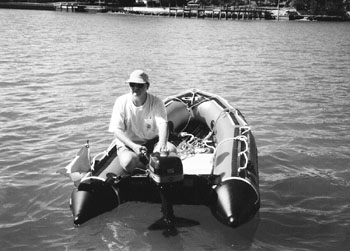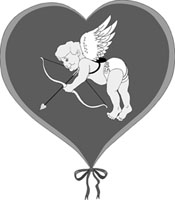

 by
Carolyn Corbett
by
Carolyn Corbett
Here’s a cruising secret that you may not know. Boaters have vivid fantasy lives. Your average male cruiser doesn’t dream of lounging on a warm sandy beach, rum drink in hand, watching his wife frolic in the surf in her brand-new, barely-there bikini. He doesn’t dream of this because that’s what he does.
No, when Mr. I.M. Boater and his mer-mate fantasize, their thoughts drift to the perfect dinghy. It’s big. It’s comfortable. It’s dry. It carries them, their guests, their laundry and groceries for two weeks dryly from shore to boat ~ and it planes to boot! It’s attractive, uses hardly any fuel, weighs less than 10 pounds, and folds to the size of a bologna sandwich for easy storage. I told you boaters have vivid fantasy lives!
Sometimes, however, you have to kiss a lot of toads before you find a prince. My first tender? Definitely a toad. It was small, it was red, and it had lived with my husband, Dave, longer than I had, so I did my best to make our relationship work. It was a 9’ Achilles whose best feature was Dave’s handmade stowing box under his seat. Powered by a two-horsepower Johnson motor, it seemed like a perfectly adequate setup.
It was, when Dave was a weekend sailor, but it didn’t measure up when we went cruising. In early December of our novice year, we were invited to join a group for our first lobstering expedition. It took us nearly an hour to get to the designated spot. Venturing away from the big boat was not an option if there were any kind of wind or waves. We arrived damp on most trips ashore, so going out to the reef was unthinkable.
It wasn’t until late December that we discovered our little 2 hp engine actually possessed only 1.3 horses! Enlightenment arrived in the form of Dick. Dick arrived following an episode at 0600 when in 40+ knots of winds, the little red toad flipped upside down on their painter behind our sailboat, Godspede ~ motor and all. As Dick rebuilt the engine for the first of three times, he reinforced what we already knew ~ we weren’t going to be happy with this outfit. The Toad wasn’t all bad. With a larger motor it might have continued to serve us. Unfortunately, the bracket on the soft stern was incapable of accommodating a larger motor.
So, in February, we bought a new-to-us dinghy. I developed a whopper of a crush on this second tender. It was big, it was handsome, and it sported a commercial grade, 6 hp Evinrude. What more could you ask for in a dinghy? Well air, for one thing.
The day after the purchase, we broke out the patch kit and put our first patch on the new dink. The next day, we put our second patch on the new dink. I won’t bore you with the day-by-day account, but we didn’t return home until May.
As the months wore on and our patience wore thin, we tried Super Glue, Shoe-Goo, you name it. Each repair lasted for a while, long enough to get our hopes up. But inevitably we’d be back at a dock hauling the blue beast out for more repairs and adhesive-drying time. Another toad. We loved the size, larger tubes, and layout of this US Marine inflatable. But we didn’t love the feeling of having an air pump as a Siamese twin.
By the time our third dinghy arrived on the scene, I was older, wiser, and experienced enough to approach this tender relationship more cautiously. Our brand-new Quicksilver, with an 8 hp Yamaha, was enough to make my heart throb, though I tried to remain impartial and let time take its course. Dave outfitted the new little boat til she was nearly perfect, with PVC rod and pear holders, non-skid strips on the floorboards, a painter of stainless steel cable covered with braid-on-braid, an Easy Lift saddle contraption for the motor, and our dive box full of gear. It was true love.
The purchase of a dinghy and motor should be determined by what the buyer intends its primary function to be. Couples looking primarily for a means of accessing shore in a dry and comfortable manner will view a dinghy with different eyes than folks who want to head a mile offshore to dive on the reefs. Cruisers who stay in close proximity to the big boat have different engine requirements than those who do a great deal of exploring. A number of boaters factor in safety, intending their dinghy to function as a life raft if disaster should strike.
Transportation from ship to shore and from boat to boat are universal uses. Many cruisers refer to their tender as the family car, station wagon, or taxi. It takes them swimming, snorkeling, exploring, and fishing. It carries provisions, functions as a tug and tow-boat, ferries the dog ashore, and serves as a "garbage scow" when cruising far from disposal facilities.
While our dinghy is specifically outfitted for diving expeditions, her other chores include ferrying fuel, water, groceries, laundry and crew from shore to land. When necessary, we use the dink to shift anchors as a front passes through.
Satisfaction with a motor is typically related to horsepower more than the make of the engine. Cruisers whose motors are less than 4 horsepower become frustrated early on. Travel with an inadequate motor can be inconveniently slow and damp. Under the wrong conditions, it can be downright dangerous. Picture yourself ashore or on a buddy’s boat when the wind pipes up — not blowing in the direction you want to go. Worse yet, consider the consequences if you’ve gone out to the reef on a mild day, only to have the tide change and your engine unable to match the strength of Mother Nature.
Overwhelmingly, seasoned sailors recommend the largest rigid bottom inflatable you can afford, and store on your boat. The BOAT/US Annual Equipment Catalog describes the pros and cons. "Rigid inflatable boats (RIBs) are the best performers, and the most expensive. Their rigid fiberglass hulls attached to inflated tubes combine the lightweight stability and buoyancy of inflatables with the speed, maneuverability and directional stability of rigid boats. They can accommodate larger outboards than other boats of comparable size, and perform almost as well as rigid boats, especially in tight turns and chop, but without the bulk and weight. A one-piece deck provides comfortable footing and a stable platform for diving or fishing. Although the tubes deflate for storage, they are not terribly compact."
• The ideal dinghy rows well, tows well, and motors well. Oars and oarlocks are designed for serious rowing rather than useless decoration. A towing eye is located on each side, rather than only on one centrally located ring.
• It has large diameter tubes for a dry ring.
• It is stable.
• It is easy to access from the water when snorkeling or diving.
• It has a hard bottom to reduce the possibility of damage from shells, coral and barnacles.
• It has a large rub rail that prevents scratching other boats when you come alongside.
• Underseat storage provides a place for necessary gear.
• It is lightweight and easy to stow.
Sounds like a prince to me! A great deal of research will precede the purchase of the next Corbett dinghy because we’re going to need it to get us around until we learn to walk on water.
All contents are copyright (c) 1998 by Northern Breezes, Inc. All information contained within is deemed reliable but carries no guarantees. Reproduction of any part or whole of this publication in any form by mechanical or electronic means, including information retrieval is prohibited except by consent of the publisher.